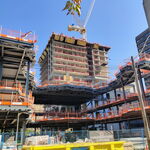Previously, there were stops at Woodbridge (on Kipling Avenue, across from the fairgrounds), Kleinburg (Nashville), and Bolton (at Station Road and Elwood Drive, just southeast of the old junction between the CP MacTier Sub mainline and the old TG&B route to Orangeville). It's interesting that Caledon protected a site on Humber Station Road north of King Road, as it's good for park-and-ride commuters from places like Caledon East, it's on the opposite end of Bolton from where most traffic is headed, though a site on Albion-Vaughan Road would not have been great either. I guess they're far enough apart that you could have both stations, plus a stop at Rutherford Road, and maybe a restoration of the Woodbridge Station with a bus loop and minimal parking.
It'd probably be only two or three trains in the peak direction only, given the low demand, which I'd think CP could work around with moderate rail infrastructure upgrades, like a double track approach to the intermodal yard from the north, and perhaps double tracking at the new GO stations.





